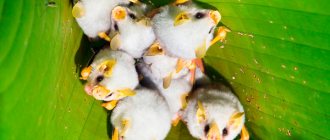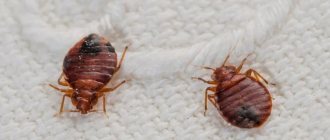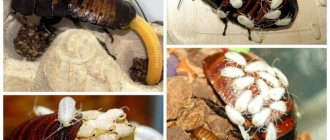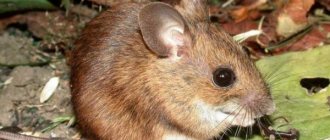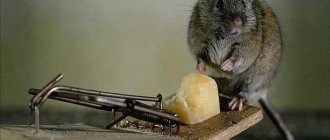Life expectancy of mice at home
At home, they usually keep a decorative breed of mouse. These, as a rule, live longer than wild ones. With the proper quality of life, they easily live up to 2-3 years, and some even cross this line and reach the age of 5 years.
The lifespan of mice varies depending on a number of factors
Pets live longer for a number of reasons:
- Living conditions. Mice are kept in cages that are always warm. In addition, caring owners always clean the inside and keep their pet’s home clean, thereby minimizing the development of various diseases.
- Nutrition. Pets do not have to find their own food, as they receive it regularly. Accordingly, they do not have such a condition as starvation. The food given to rodents contains the nutrients they need.
- No predators. Mice are easy prey for many predators. At home, they are completely safe and are not even exposed to stress, which can be detrimental to them.
Mice can get along well with people
Most often, mice at home die from old age, disease or genetic disorders. Otherwise, they can be considered quite tenacious.
White house (laboratory) mouse
These rodents have long since lost their wild nature. Recently, they are very often found among people as pets. Their mass maintenance began about 125 years ago. These rodents are sociable and unpretentious in care.
It is best for a white mouse to get used to a person if you purchase a month-old rodent. After purchasing it, you need to pick it up and play with it more often. These rodents are highly trainable.
Feeding is not difficult, they eat a variety of rodent foods. The white mouse eats greens, vegetables, and cereals. Never give your rodents fried or fatty foods. It is useful to supplement the diet with mealworms or other invertebrates.
For growing incisors, you need to add twigs of shrubs or stone fruit trees and crackers to the diet of young animals.
The duration of pregnancy in a rodent of this species is approximately twenty days. The female brings about seven babies, although there are more. A mouse can give birth to about ten litters per year.
Rodents must live in a cage. There must be a house in it. It is also advisable to install a wheel or additional accessories for games. The optimal temperature for keeping is twenty degrees.
In addition to white mice, there are also gray mice. They are also a subspecies of domestic ones. A gray mouse weighs about thirty grams on average, and its body length is about ten centimeters. The length of the tail of this mouse is 10 cm. The rodent's fur is hard. The coloring is monochromatic.
The diet of domestic mice should contain grain crops, such as:
- Millet
- Wheat
- Barley
- Corn.
In addition, your pet's menu must include protein foods (unsalted cheese, eggs, low-fat cottage cheese), as well as bread crumbs.
You can purchase ready-made grain mixtures for pet mice at any Zoogalereya store.
We suggest you read: When do kittens start pooping and how many times a day should they do it?
You can offer your pet seasonal fruits: pears, plums, apples. Don't forget to cut them into small pieces.
Just like degu squirrels, the care of which we have already talked about in our article, mice need to grind their teeth. Branches of birch and fruit trees are suitable for this purpose.
It is customary to put forward different versions of the lifespan of decorative rats. The peak of longevity is 7 years, and it is noted in the book of records. However, practice shows that, in fact, rats live 2-2.5 years. On average, out of 100-120 rodents, only 3 live to be 3 years old. Males succeed in this more often than females. For a pet to be 3 years old, this is already a very old age, and if he managed to reach 3.5 years old, this is almost the limit.
The lifespan of different animal species is determined at the genetic level. It depends on the animal's ability to reproduce. Rats can breed as early as 1.5 months. A rodent can have up to 14 cubs in a litter. A nursing rat is ready to become pregnant and give birth to new offspring. For this reason, animals of different sexes cannot be kept in the same cage: this is an extra burden on the female.
Another reason for a short life span is rapid metabolism. Because of this, the rat can die without food within 2 days.
To date, several breeds of rats have been bred, which differ in the structure of their fur, color, and location of their ears. There is a breed of tailless rodents. Although the question here is debatable whether they can be distinguished as a separate breed. If you take a few of the most famous breeds, you get the following:
- standards - rats similar to wild ones. They can have different colors, for example, a blue rat is distinguished by the azure shade of its fur coat;
- bald sphinxes are animals without hair;
- rexes have short, curly hair;
- Double Rexes are shedding rats with fur of varying lengths;
- Dumbo - animals with large “elephant” ears;
- anurans;
- husky - color like a dog of the same breed;
- satin - animals with thin shiny fur.
This is an approximate list that will allow you to identify individual breeds according to their endurance.
White rats of various breeds live the shortest. This is due to the fact that they were bred as laboratory animals, so they have certain damage in their genome. Animals rarely reach 2 years of age.
Sphinxes are quite vulnerable. Lack of fur increases the risk of skin injury and associated infections. The naked body suffers from temperature changes and sunburn.
Tailless individuals lack balance - a rudder, which increases the risk of injury. The tail also serves as protection for the back of the animal.
11 January 2013, 16:19
It is not always possible to understand from the appearance of an animal how old it actually is. In any case, the average life expectancy of small pets is incomparably short in relation to human life.
But this does not mean that the biological age of an animal is not comparable to the biological age of a person. Let's see how long our pets live in terms of human years.
The average lifespan of a rat is 2-3 years. However, good care and feeding can increase the life of your pet. Animals born from healthy parents live longer. But in terms of human years, 2 years of a rat’s life are equal to 60 human years.
The average lifespan of a mouse is 2-3 years, but long-livers are known who have lived for more than 5 years. In addition, the lifespan of a mouse can vary depending on the size and breed. 19 months of mouse life is equivalent to 60-65 years in human terms.
The life of a hamster is short. On average, in captivity it is approximately 2-2.5 years, but under good conditions, a hamster can live 3 or even 4 years, and may die a few days after purchase.
It all depends on the health of the hamster, on the conditions in which it was kept before purchase, how well it tolerated transportation and how quickly it adapted to the new living conditions.
And one year of a hamster’s life is equivalent to 25 human years.
Guinea pig
The average lifespan of guinea pigs is about 7-8 years. Centenarians have been known to live for 15 years. And every year of a pig’s life is equal to about 10-15 human years.
Rabbit
The natural lifespan of rabbits is 6-8 years; some rabbits can live up to 10 years. And at 8 years old, rabbits become real long-livers by human standards. This age in a rabbit is equivalent to 100 years of human life.
Parrot
The idea that parrots can live 100 years or more is a misconception. In fact, the life expectancy of parrots rarely exceeds 50 years (and then only in large species). And small parrots, for example, budgerigars, will only live about 10-15 years. But if you consider that 1 year of life of a budgerigar is equal to approximately 7 human years, this is not so little.
Canary
The canary is easily tamed, quite trusting, amenable to “education” and successfully reproduces at home. The quality and activity of singing, reproduction, and longevity of the bird depend on the proper maintenance and care of the bird. Canaries can live at home for 7-12 years. And their life expectancy in human years is the same as that of parrots - 1/7.
Turtle
With careful maintenance and proper care at home, a turtle can live 20-30 years. Multiply this figure by 5, and you will understand that in the human world, turtles would be real long-livers.
This is some funny arithmetic. In general, the more you love your pet, the better you take care of it, the greater the likelihood that, even if it does not become a long-liver, it will always be cheerful, healthy and happy.
Lifespan of mice in nature
What do mice eat in nature and at home - list of products
In general, the age of mice in nature rarely exceeds 14 months, but more often it is about 10 months, which is more than 2 times less than that of domestic mice. This is influenced by a number of features of living in the wild:
- Predators. The big problem with mice is that they can be eaten at any age. They are hunted by snakes, birds, foxes, martens and other enemies.
- Food. In the summer, this problem rarely arises, but many animals do not survive the winter without food. Accordingly, the lifespan of mice is limited to the season when they can feed.
- Climate. Mice are not very picky about their living conditions, but despite this they do not tolerate extreme heat, severe frosts, or temperature fluctuations.
- People. On some level, it is also fashionable to call them enemies of rodents. After all, the latter constantly invade their home in order to find food or shelter. The person, in turn, sets traps, scatters poison and tries in every possible way to get rid of uninvited guests.
Rodents are able to survive in any conditions
It turns out that mice in nature often die from exposure to a number of factors, rather than from their own death.
House and decorative mice
The house mouse can live both close to people and in the wild in wooded areas or fields. Prefers to live in places with well-moistened soil. The average life expectancy in nature is very short - about a year. The animal is in constant fear of being caught by predatory animals, such as:
- foxes;
- predators of the mustelid family (marten, weasel, ferret, mink, badger and others);
- birds of prey (owl, hawk, falcon, eagle and others);
- large reptiles (snakes, lizards).
Mouse in nature
She lives in small burrows about a meter long. Deep in the underground labyrinth there is a nesting chamber where the female lives with her cubs.
In winter, the rodent can migrate up to 5 km closer to the countryside. There, mice live in barns, haystacks and feed on livestock feed or human food supplies found in cellars and pantries. During the summer, they return to natural conditions.
Fortunately for mice, many people are partial to the small rodents and keep them as pets. In such conditions, mice live long and carefree. Comfortable conditions in the cage, regular food and entertainment in the form of special toys, ladders, and wheels for rotation are created for the animal.
How long a rodent can live depends on timely care and the conditions created by the pet’s owner. Mice live as pets for about 3 years. The maximum age that a house mouse could live to in laboratory conditions is 5 years.
The lifespan of mice is not very long - usually 1.5-3 years. In impeccable conditions of detention - a maximum of 5 years.
Keeping in mind the average period of how long a house mouse lives, let's think about expanding its time frame. To do this you need:
- provide the pet with the most comfortable living conditions;
- balance the diet and bring it as close as possible to the needs of a small organism;
- protect the animal from domestic predatory pets;
- monitor the health status of your pet, which directly depends on the conditions of detention, cleanliness and the intake of nutrients into the body.
How long can they live without food and water?
Food is an integral part of the life of any living organism, and rodents are no exception. In general, they rarely go without food, as they feed on everything. During the cold season, mice try to get closer to people, where they can always find something. If the animal does not have this opportunity, then its average lifespan will be 10 days.
How long do toy terriers live at home?
Rodents consume water not only directly from reservoirs, but also from succulent herbaceous plants. Accordingly, its shortage occurs extremely rarely. But if you leave a mouse locked in a cage without water, it will not live more than 3 days.
For your information! Babies cannot drink on their own for the first 3 weeks of their lives; they depend on their mother. This means that one mouse will not live more than half a day.
Gerbil
These rodents are well suited for keeping in an apartment. Gerbils are more active during daylight hours. They are easy to train and are non-aggressive towards people.
The natural habitat is deserts and semi-deserts. In appearance, the rodent resembles a jerboa, thanks to its elongated hind limbs and tail with a tassel at the end.
Rodents reproduce very well and are not picky about food.
We suggest you read: How many years do Bengal cats live at home?
The cage for a gerbil should be metal, measuring 40x50 cm or more.
The rodent should be fed legumes, herbs, and cereals. They also consume hay and branches of soft trees (poplar, willow and others). Sprouted grains are beneficial for the gerbil. The rodent also loves vegetables, berries and fruits, not only fresh, but also dry. Sometimes give your gerbil fermented milk products, cottage cheese, mealworms, dry gammarus and more. Rodents readily eat gray bread.
Tubular bones of farm animals and chalk should be used for mineral feeding of pets. There must be water in the cage at all times.
Gerbils have movable front legs, so they often use them when eating food for convenience.
From the end of winter until late autumn, these rodents breed. There are up to five cubs in one litter. But, unfortunately, not everyone survives. The gestation period of such an animal is 23 days. After the birth of the babies, it is not necessary to remove the male.
At the age of twelve days, babies already begin to eat on their own. During this period, they also continue to feed on mother's milk.
How does life expectancy depend on breed?
How long do castrated cats live at home: lifespan
How long mice live is also affected by their species. The most common of them are homemade: decorative and white. They are worth considering in more detail. As for other popular breeds:
- Vulcanovaya. They can be kept at home. It is a fairly large specimen, the body length of which can reach 15 cm and weight 60 grams. With proper care, it lives up to 5 years.
- Zebra. It got its name from its striped coat. This breed is not known for its sociability and practically does not go near people, so they can be classified as wild. The lifespan of such a mouse is about 4 years, but only under the condition that a person can still tame it. In nature, they are unlikely to be able to last that long.
- Baby. The smallest type. They treat people with caution and are very timid. At the same time, if you managed to get this rodent, it is not difficult to establish contact with it. Their lifespan is 3 years.
- Fazza. A rodent that has no guard hair, that is, almost bald. They get along with people better than others - they love to play and are very friendly. However, due to the lack of hair, they have a specific smell, so they require special care. They live for about 2 years.
- Satin. It is very rare and famous for its color. He is good friends with people and lives for about 2 years.
- Gerbil. Another species that is often kept at home. They are sociable and, importantly, have virtually no foreign odor. Sandstone are long-lived and can please their owner for about 5 years.
- Voles. Miniature mice living in meadows, dense bushes, and vegetable gardens. People generally classify them as pests because they can destroy crops. If nothing threatens the field rodent, it can live up to 7 years.
Vole at home
Important! For a pet to live a full life, it needs appropriate conditions.
How long do white mice live?
White mice are more common than others and are often sold in pet stores. They make good contact with people. This species was bred in laboratory conditions and is a domesticated descendant of the house mouse. This breed is used for all kinds of research.
If this species is kept in good conditions and high-quality food is selected for it, it can live for 3 years. However, this figure is often higher. The maximum recorded age for how long white mice live is 7 years.
White mouse (albino)
How long do decorative mice live?
The decorative appearance has thick, monochromatic wool. There are black, gray, sandy and brown rodents. They are sold en masse in pet stores. The size of such a rodent ranges from 7-12 cm, excluding the tail, and the weight is about 60 grams. On average, they live about 2.5 years.
It is important to consider that these rodents are school animals, so they get along better in company, and accordingly, how long a decorative mouse will live will depend on this. It is worth keeping individuals of the same sex, as they are capable of breeding all year round.
Interesting facts about mice
The word "mouse" is derived from the ancient Indo-European word "mush", which translates as "thief".
Mice are very fertile. Females are able to give birth 3-6 times a year, bringing 3-10 mice at a time.
Mice reach sexual maturity at 1.5-3 months.
Due to the huge number of predators that feed on mice, their lifespan in the wild is only 6-9 months. In captivity, mice can live up to 4-5 years.
Interesting fact: The Methuselah Foundation, which encourages research into human life extension, annually awards the M-Prize to scientists who have managed to increase the lifespan of laboratory mice. The amounts awarded to the owners of the Methuselah Mouse Prize can reach several million dollars.
It is believed that elephants are terrified of mice. However, as experiments have shown, in most cases, elephants pay absolutely no attention to mice. So this is nothing more than a myth.
The first mass cultural image of a mouse is Mickey Mouse. The famous mouse appeared on screens in 1928.
Over 80% of all chemical, biological and medical experiments in the world are carried out on mice and their closest relatives - rats.
The smallest mouse is the tiny mouse, whose body length is only 5-7 cm (without tail) and weight is 7-10 g. Interestingly, a newborn mouse of this species weighs less than one gram!
The love of mice for cheese is well known. However, experiments have shown that these rodents most like sweet foods, for example, sugar and fruit. So cheese is far from their favorite delicacy. Moreover, it turns out that mice cannot stand the strong smell of cheese!
In many countries in Asia, Africa and Latin America, mouse meat is included in the daily diet. In Malawi and Zambia, dishes made from mice are a “feature” of national cuisines.
Interestingly, the name of the company is translated as “Delicious Rodent”.
In the Philippines, mouse hunting is common, and the hunters are more than seriously armed: machetes and flamethrowers.
Spine mice, which live in a number of countries in the Middle East and Africa, are capable of shedding part of their skin in times of danger to distract predators. Interestingly, in place of the shed skin, a new one very quickly forms, which is subsequently covered with fur.
In 2010, in one of the US laboratories, a previously unstudied gene was removed from mice. As a result, the mice became smarter, remembering their surroundings faster and finding hidden food.
Interestingly, humans also have a similar “dumbing down” gene. True, scientists do not risk removing it, since they do not fully understand the role of this gene in the human body.
The researchers jokingly called it the “Homer Simpson gene.”
All house mice suffer from farsightedness, since the lenses in their eyes are almost incapable of accommodation.
The hearing of an ordinary house mouse is about 5 times better than that of a human. If people hear sounds with a frequency of up to 20 kilohertz, then mice – up to 100.
At the end of the 19th century, the National Mouse Club was founded in Great Britain, which was engaged in breeding new breeds of domestic mice. Interestingly, the club is still active today.
animals, interesting, mouse, facts
How to extend the lifespan of mice
First of all, life expectancy depends on the conditions in which the rodent will live. It requires comfort, namely:
- Space. The mouse will do well in a spacious cage with room to play. He will also need a house. Rodents love to hide and sleep in secluded places. To add variety to your pet’s days, it’s worth installing a wheel, shelves, a ladder, and a rope in the cage. Such accessories will help him do the necessary physical activity and entertain himself.
- Litter. For such animals, sand and cotton wool are unacceptable. In the first case, there is a risk of developing lice, and in the second, there is discomfort in the form of an unpleasant odor and tangled paws. It is optimal to use sawdust, hay, shavings, and peat chips. The layer must be at least 0.5 cm.
- Climate. Do not leave the animal in direct sunlight or in a draft. They don't tolerate it well and may even die. You also need to make sure that the mouse is not exposed to cold or heat for a long time.
- Walks. No matter how spacious the cage is, it is still cramped for the rodent. If possible, you should let the mouse run around the house. However, you need to make sure in advance that nothing will harm him and that there are no places in the room where he could hide.
A cage equipped with everything you need
For your information! The rodent is not a friend to other pets, but rather prey for many of them, so the cage must be kept out of reach.
Enemies of mice
The mouse is a key link in the food chain of many ecosystems. Many wild animals depend on the existence of this small rodent. For mice living in the forest, the main enemies are foxes, martens, arctic foxes, ferrets, stoats, weasels, lynxes and even wolves. Predators easily tear apart burrows and can eat up to 30 small animals a day.
Mice are the main food for snakes and large lizards. Reptiles such as boas, pythons, vipers, and radiant snakes swallow their prey whole. During the hunt, the snake freezes, and then suddenly attacks the victim, biting it with poisonous teeth, and then waits for the animal to become motionless.
There is also danger lurking for mice from above. Among birds there are predators that differ in the power of their beaks, visual acuity and hearing. These are owls, buzzards, hawks, eagles, owls, kites. They hunt during the day or night, making swift attacks from the air.

